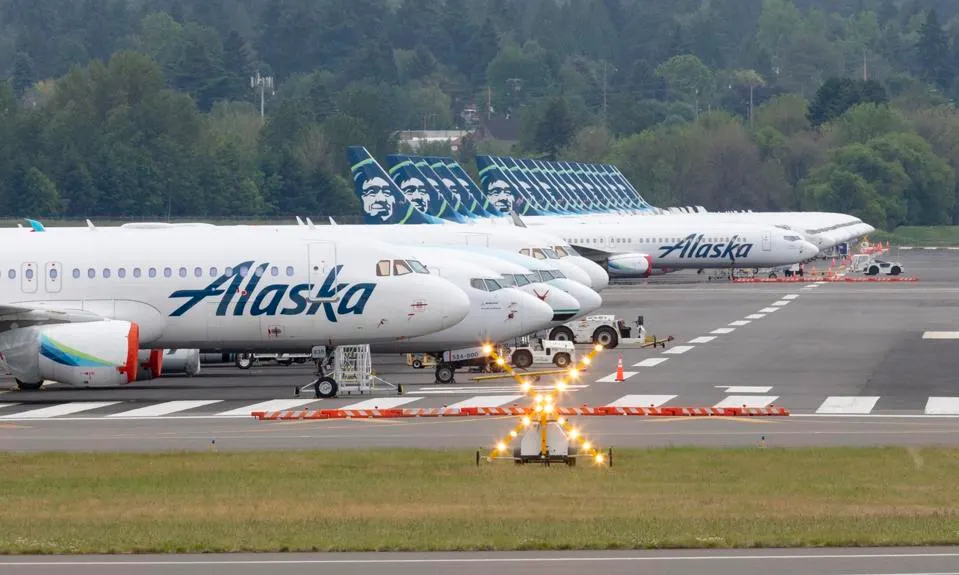On Sunday, July 20, 2025, a widespread IT system failure led to the sudden grounding of all Alaska Airlines flights, marking a serious disruption in U.S. domestic air travel. The Alaska Airlines ground stop, requested by the airline itself, triggered major delays and cancellations across the country, especially at SeaTac Airport in Seattle — Alaska’s primary hub.
What Happened?
A critical server failure caused by a hardware issue at a third-party data center disabled vital operational systems at Alaska Airlines, including:
- Flight scheduling
- Crew tracking
- Weight and balance calculations
- Maintenance oversight
This failure impacted both Alaska Airlines and its regional partner Horizon Air, grounding over 300 aircraft temporarily.
The airline issued an immediate ground stop request to the FAA, halting all Alaska Airlines flights nationwide. The FAA Alaska Airlines ground stop lasted approximately three hours, leading to:
| Impact Area | Details |
|---|---|
| Flights Canceled | 150+ |
| Flights Delayed | 430+ |
| Primary Airport Hit | SeaTac (Seattle-Tacoma Airport) |
| Total Affected | Thousands of passengers stranded |
Timeline of the Alaska Airlines Ground Stop
| Time (Pacific Time) | Event Description |
|---|---|
| 8:00 PM | Critical IT outage detected at Alaska Airlines HQ |
| 8:10 PM | **FAA Alaska Airlines ground stop** officially issued |
| 11:00 PM | Systems partially restored, flights resume slowly |
| Overnight | SeaTac overwhelmed; crews and aircraft out of sync |
| Next Morning | Delays and cancellations spill into next day |
Who Was Affected?
The alaska airlines grounded today event impacted both commercial and regional operations:
- Alaska Air: Mainline domestic and cross-country routes
- Horizon Air: Regional partner operating short-haul flights
- SeaTac Airport: Overloaded due to passenger buildup
- Other Airports: Ripple delays in Portland, San Francisco, Los Angeles
Passengers described crowded gates, overwhelmed service counters, and confusion around alaska airlines flight status updates.
Why Did It Happen?
Alaska Airlines confirmed the incident was not a cyberattack but rather a hardware failure that struck its core server infrastructure. This caused a domino effect, disabling:
- Aircraft dispatch systems
- Crew readiness tools
- Real-time maintenance tracking
This was a failure in redundancy. Even though systems were “multi-redundant,” the failure suggests gaps in disaster recovery or switching mechanisms.
FAA Involvement
The FAA Alaska Airlines ground stop was officially requested by the airline. The FAA:
- Authorized the suspension of Alaska flights
- Coordinated with SeaTac ground teams
- Cleared resumed operations once systems recovered
Where It Was Most Severe: SeaTac Airport
SeaTac Airport in Seattle is Alaska Airlines' home base and most affected by this alaska air ground stop.
| Location | Canceled Flights | Delayed Flights |
|---|---|---|
| SeaTac Airport | 45+ | 200+ |
| Portland | 15+ | 50+ |
| LAX/SFO | Minor | 30+ each |
| Local news agencies reported massive lines at **alaska airlines counters**, and even **automated kiosks** failed due to the outage. |
Was This the First Time?
No. Alaska Airlines has experienced multiple technology-related disruptions in recent memory:
| Date | Incident |
|---|---|
| Jan 2024 | Mid-air panel separation on Boeing 737 MAX |
| Apr 2024 | Weight-and-balance software malfunction |
| Jul 2025 | Full operational outage due to hardware issue |
| These repeated failures raise concern over **IT infrastructure readiness** and **disaster recovery policies**. |
Ongoing Investigations
Internal Audit
Alaska Airlines is launching a full audit of:- Third-party server dependencies
- Backup protocol readiness
- Ground-stop trigger mechanisms
FAA Inquiry
FAA will assess:- Ground stop timing and communication
- Resumption procedures
- National airspace coordination protocols
Industry-Wide Concerns
Other carriers may follow suit by:- Stress testing their IT environments
- Improving redundancy systems
- Enhancing real-time disaster simulations
What Alaska Airlines Said
Alaska Air released a public statement:
"We apologize to our guests for the disruption. Safety was never compromised. We are investigating the cause and improving our systems."
They also advised passengers to keep receipts for food, lodging, or transportation costs incurred due to delays or cancellations.
Lessons for Passengers
If you're affected by an alaska airlines outage, here’s what you should do:
- Check Alaska Airlines flight status on the official app or site
- Save receipts for any expense (meals, hotels, taxis)
- Sign up for alerts on rebooking or compensation offers
- Arrive early — even if your flight is still listed as "on time"
- Be patient — airline crew and staff are also caught in the disruption
Broader Implications for Airlines
This event adds urgency to several ongoing aviation concerns:
- Digital resilience: Airlines are tech-driven. Without IT, planes can’t move.
- Backup systems: Redundant systems must be actually usable in crises.
- FAA tech oversight: There’s increasing demand that FAA regulate airline IT standards.
- Passenger rights: Reimbursement clarity is now expected.
Final Word
The Alaska Airlines flights grounded situation highlights a serious issue in the modern aviation ecosystem — dependency on IT infrastructure with limited failovers. While no lives were endangered and safety remained a priority, passenger experience suffered immensely, especially at SeaTac.
As Alaska Airlines resumes normal service and reviews the incident, this will likely shape how the airline—and the industry—manages IT risks going forward.


